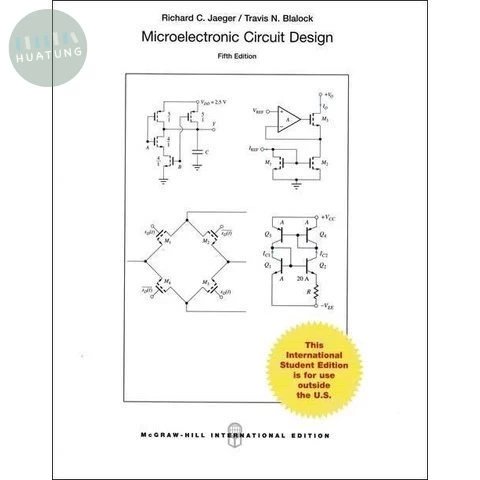
微電子學(上)(Neamen 4/e) (4版)
人氣推薦!已有5位會員共同選購!!
【中文翻譯書】
書名:微電子學(第四版) 上冊/下冊
原文書名:Microelectronics: Circuit Analysis and Design 4/E
審閱:呂學士/劉深淵/劉致為
譯者:陳筱青/謝瑞航
作者: Donald A. Neamen
出版社:滄海
ISBN:9789861577937/9789861578477
●內容完整詳盡,組織架構清晰:本書主要分為三個部分。第一部分探討半導體元件及基本電路應用;第二部分探討類比電子學中較高階的主題;第三部分則論述數位電子電路。此三部分可彼此獨立,卻又環環相扣。
●精心設計例題,靈活運用理論觀念:本書含有許多「設計例」及PSPICE電腦模擬問題,可帶領學生靈活運用基本觀念,增強理解能力,奠定學生分析及設計類比與數位電子電路的根基。各電路中的電壓值以及MOSFET元件參數與現今電子電路情況相符,可增進學生於產業界技術水準之認知。
第四版新注入的元素
●增加了超過 250 個新練習題與「測試你的了解程度」練習題。
●增加了超過 580 個新章後習題。
●增加了超過 50 個新開放式設計習題於章後習題區。
●增加了超過 65 個新電腦模擬習題於章後習題區。
●電路中的電壓值被修改成與現今電子電路較相符合的情況。
●MOSFET 元件參數被修改成與現今電子電路較相符合的情況。
●第9 章被重新改寫,使讀者可將理想運算放大器做為學習電子學時的第一個主題。
●維持足夠嚴謹的數學推導,使讀者能更清楚地理解基本電路操作原理與特性。
上冊目錄
PROLOGUE I 電子學的前言
PART 1 半導體元件及基本應用
第1章 半導體材料與二極體
第2章 二極體電路
第3章 場效電晶體
第4章 基本場效電晶體 (FET) 放大器
第5章 雙極接面電晶體
第6章 基本雙極電晶體放大器
附錄A 物理常數及轉換因子
附錄B 精選之製造商的數據表
附錄C 標準電阻及電容值
附錄D 參考文獻
附錄E 問題解答
下冊目錄
第 7 章 頻率響應
第 8 章 輸出級與功率放大器
PROLOGUE II 電子設計的前言
PART 2 類比電子學
第 9 章 理想操作放大器及其電路
第 10 章 積體電路偏壓與主動負載
第 11 章 差動與多級放大器
第 12 章 回授與穩定度
第 13 章 操作放大器電路
第 14 章 操作放大器電路中的非理想效應
第 15 章 積體電路的應用與設計
PROLOGUE III 數位電子學的前言
PART 3 數位電子學
第 16 章 MOSFET 數位電路
第 17 章 雙極電晶體數位電路
附錄 A 物理常數及轉換因子
附錄 B 精選之製造商的數據表
附錄 C 標準電阻及電容值
附錄 D 參考文獻
附錄 E 問題解答
立即查看

微電子學(下)(Neamen 4/E) (4版)
其他會員也一起購買
【中文翻譯書】
書名:微電子學(第四版) 上冊/下冊
原文書名:Microelectronics: Circuit Analysis and Design 4/E
審閱:呂學士/劉深淵/劉致為
譯者:陳筱青/謝瑞航
作者: Donald A. Neamen
出版社:滄海
ISBN:9789861577937/9789861578477
●內容完整詳盡,組織架構清晰:本書主要分為三個部分。第一部分探討半導體元件及基本電路應用;第二部分探討類比電子學中較高階的主題;第三部分則論述數位電子電路。此三部分可彼此獨立,卻又環環相扣。
●精心設計例題,靈活運用理論觀念:本書含有許多「設計例」及PSPICE電腦模擬問題,可帶領學生靈活運用基本觀念,增強理解能力,奠定學生分析及設計類比與數位電子電路的根基。各電路中的電壓值以及MOSFET元件參數與現今電子電路情況相符,可增進學生於產業界技術水準之認知。
第四版新注入的元素
●增加了超過 250 個新練習題與「測試你的了解程度」練習題。
●增加了超過 580 個新章後習題。
●增加了超過 50 個新開放式設計習題於章後習題區。
●增加了超過 65 個新電腦模擬習題於章後習題區。
●電路中的電壓值被修改成與現今電子電路較相符合的情況。
●MOSFET 元件參數被修改成與現今電子電路較相符合的情況。
●第9 章被重新改寫,使讀者可將理想運算放大器做為學習電子學時的第一個主題。
●維持足夠嚴謹的數學推導,使讀者能更清楚地理解基本電路操作原理與特性。
上冊目錄
PROLOGUE I 電子學的前言
PART 1 半導體元件及基本應用
第1章 半導體材料與二極體
第2章 二極體電路
第3章 場效電晶體
第4章 基本場效電晶體 (FET) 放大器
第5章 雙極接面電晶體
第6章 基本雙極電晶體放大器
附錄A 物理常數及轉換因子
附錄B 精選之製造商的數據表
附錄C 標準電阻及電容值
附錄D 參考文獻
附錄E 問題解答
下冊目錄
第 7 章 頻率響應
第 8 章 輸出級與功率放大器
PROLOGUE II 電子設計的前言
PART 2 類比電子學
第 9 章 理想操作放大器及其電路
第 10 章 積體電路偏壓與主動負載
第 11 章 差動與多級放大器
第 12 章 回授與穩定度
第 13 章 操作放大器電路
第 14 章 操作放大器電路中的非理想效應
第 15 章 積體電路的應用與設計
PROLOGUE III 數位電子學的前言
PART 3 數位電子學
第 16 章 MOSFET 數位電路
第 17 章 雙極電晶體數位電路
附錄 A 物理常數及轉換因子
附錄 B 精選之製造商的數據表
附錄 C 標準電阻及電容值
附錄 D 參考文獻
附錄 E 問題解答
立即查看

數位邏輯設計Digital Logic Design―使用Verilog HDL6/e (6版)
其他會員也一起購買
【中文書】
書名:數位邏輯設計:使用Verilog HDL(第六版)
作者:林銘波
出版社:全華
出版日期:2017/09/01
ISBN:9789864635948
內容簡介
1.由淺入深完整的介紹數位邏輯的原理,並且以豐富的說明例,闡述每一個基本原理與觀念。
2.詳細介紹各種組合邏輯電路模組的設計原理,這些模組包括:解碼器、編碼器、多工器、解多工器、…、算術運算電路等。
3.詳細介紹各種循序邏輯電路模組的設計原理,這些模組包括:計數器、暫存器、移位暫存器、序列產生器、…等。
4.詳細介紹PLD元件(ROM、PLA、PAL)的結構、特性、應用電路設計。
5.使用Verilog HDL程式實例介紹CPLD/FPGA元件的應用系統設計。
6.專章提供了20個數位邏輯電路的基本與應用實驗予讀者練習及驗證理論與實務的一致性。
7.每一小節皆提供豐富的複習問題,幫助讀者自我評量對該小節內容了解的程度,並且提供教師當作隨堂測驗的參考題目。
■ 內容簡介
本書由淺入深,完整地介紹數位邏輯的原理,並且以豐富的實例 ,闡述每一個原理與觀念,詳細介紹各種組合、序向邏輯電路模組設計原理,以及PLD元件的結構、特性、應用電路設計。使用VerilogHDL程式,介紹CPLD/FPGA元件的ASIC應用設計,並提供了20個數位邏輯電路實驗,讓讀者練習及驗證。
立即查看

Modern Physics (4版)
其他會員也一起購買
【簡介】
One of the field’s most respected introductory texts, Modern Physics provides a deep exploration of fundamental theory and experimentation. Appropriate for second-year undergraduate science and engineering students, this esteemed text presents a comprehensive introduction to the concepts and methods that form the basis of modern physics, including examinations of relativity, quantum physics, statistical physics, nuclear physics, high energy physics, astrophysics, and cosmology. A balanced pedagogical approach examines major concepts first from a historical perspective, then through a modern lens using relevant experimental evidence and discussion of recent developments in the field. The emphasis on the interrelationship of principles and methods provides continuity, creating an accessible “storyline” for students to follow.
Extensive pedagogical tools aid in comprehension, encouraging students to think critically and strengthen their ability...
【目錄】
1. Some Deficiencies of Classical Physics 1
1.1 Review of Classical Physics 3
1.2 Deficiencies in Classical Concepts of Space and Time 11
1.3 Deficiencies in the Classical Theory of Particle Statistics 13
1.4 Theory, Experiment, Law 21
Questions 22
Problems 23
2. The Special Theory of Relativity 25
2.1 Classical Relativity 26
2.2 The Michelson–Morley Experiment 29
2.3 Einstein’s Postulates 31
2.4 Consequences of Einstein’s Postulates 32
2.5 The Lorentz Transformation 41
2.6 The Twin Paradox 46
2.7 Relativistic Dynamics 48
2.8 Conservation Laws in Relativistic Decays and Collisions 54
2.9 Experimental Tests of Special Relativity 58
Questions 65
Problems 66
3. The Particle-Like Properties of Electromagnetic Radiation 71
3.1 Review of Electromagnetic Waves 72
3.2 The Photoelectric Effect 77
3.3 Thermal Radiation 83
3.4 The Compton Effect 90
3.5 Other Photon Processes 93
3.6 Particles or Waves 96
Questions 99
Problems 100
4. The Wavelike Properties of Particles 105
4.1 De Broglie’s Hypothesis 106
4.2 Experimental Evidence for De Broglie Waves 108
4.3 Uncertainty Relationships for Classical Waves 115
4.4 Heisenberg Uncertainty Relationships 118
4.5 Wave Packets 124
4.6 The Motion of a Wave Packet 128
4.7 Probability and Randomness 131
Questions 133
Problems 134
5. The Schrödinger Equation 139
5.1 Behavior of a Wave at a Boundary 140
5.2 Confining a Particle 144
5.3 The Schrödinger Equation 146
5.4 Applications of the Schrödinger Equation 150
5.5 The Simple Harmonic Oscillator 162
5.6 Steps and Barriers 165
Questions 173
Problems 174
6. The Rutherford-Bohr Model of the Atom 177
6.1 Basic Properties of Atoms 178
6.2 Scattering Experiments and the Thomson Model 179
6.3 The Rutherford Nuclear Atom 182
6.4 Line Spectra 188
6.5 The Bohr Model 191
6.6 The Franck-Hertz Experiment 197
6.7 The Correspondence Principle 199
6.8 Deficiencies of the Bohr Model 201
Questions 203
Problems 203
7. The Hydrogen Atom in Wave Mechanics 207
7.1 A One-Dimensional Atom 208
7.2 Angular Momentum in the Hydrogen Atom 210
7.3 The Hydrogen Atom Wave Functions 213
7.4 Radial Probability Densities 218
7.5 Angular Probability Densities 220
7.6 Intrinsic Spin 222
7.7 Energy Levels and Spectroscopic Notation 227
7.8 The Zeeman Effect 228
7.9 Fine Structure 230
Questions 232
Problems 233
8. Many-Electron Atoms 237
8.1 The Pauli Exclusion Principle 238
8.2 Electronic States in Many-Electron Atoms 240
8.3 Outer Electrons: Screening and Optical Transitions 244
8.4 Properties of the Elements 248
8.5 Inner Electrons: Absorption Edges and X Rays 253
8.6 Addition of Angular Momenta 257
8.7 Lasers 261
Questions 265
Problems 266
9. Molecular Structure 269
9.1 The Hydrogen Molecule 270
9.2 Covalent Bonding in Molecules 274
9.3 Ionic Bonding 282
9.4 Molecular Vibrations 286
9.5 Molecular Rotations 290
9.6 Molecular Spectra 294
Questions 298
Problems 299
10. Statistical Physics 303
10.1 Statistical Analysis 304
10.2 Classical and Quantum Statistics 306
10.3 The Density of States 310
10.4 The Maxwell–Boltzmann Distribution 315
10.5 Quantum Statistics 321
10.6 Applications of Bose–Einstein Statistics 324
10.7 Applications of Fermi–Dirac Statistics 330
Questions 336
Problems 337
11. Solid-State Physics 341
11.1 Crystal Structures 342
11.2 The Heat Capacity of Solids 350
11.3 Electrons in Metals 354
11.4 Band Theory of Solids 358
11.5 Superconductivity 364
11.6 Intrinsic and Impurity Semiconductors 369
11.7 Semiconductor Devices 372
11.8 Magnetic Materials 376
Questions 383
Problems 384
12. Nuclear Structure and Radioactivity 389
12.1 Nuclear Constituents 390
12.2 Nuclear Sizes and Shapes 392
12.3 Nuclear Masses and Binding Energies 394
12.4 The Nuclear Force 399
12.5 Quantum States in Nuclei 401
12.6 Radioactive Decay 403
12.7 Alpha Decay 407
12.8 Beta Decay 410
12.9 Gamma Decay and Nuclear Excited States 414
12.10 Natural Radioactivity 418
Questions 421
Problems 423
13. Nuclear Reactions and Applications 427
13.1 Types of Nuclear Reactions 428
13.2 Radioisotope Production in Nuclear Reactions 432
13.3 Low-Energy Reaction Kinematics 434
13.4 Fission 437
13.5 Fusion 443
13.6 Nucleosynthesis 450
13.7 Applications of Nuclear Physics 453
Questions 459
Problems 459
14. Elementary Particles 463
14.1 The Four Basic Forces 464
14.2 Classifying Particles 466
14.3 Conservation Laws 471
14.4 Particle Interactions and Decays 475
14.5 Energy and Momentum in Particle Decays 481
14.6 Energy and Momentum in Particle Reactions 483
14.7 The Quark Structure of Mesons and Baryons 487
14.8 The Standard Model 494
Questions 499
Problems 499
15. Cosmology: The Origin and Fate of the Universe 503
15.1 The Expansion of the Universe 504
15.2 The Cosmic Microwave Background Radiation 508
15.3 Dark Matter 510
15.4 The General Theory of Relativity 512
15.5 Tests of General Relativity 519
15.6 Stellar Evolution and Black Holes 523
15.7 Cosmology and General Relativity 528
15.8 The Big Bang Cosmology 530
15.9 The Formation of Nuclei and Atoms 533
15.10 Experimental Cosmology 536
Questions 541
Problems 542
Appendix A: Constants and Conversion Factors 545
Appendix B: Complex Numbers 547
Appendix C: Periodic Table of the Elements 549
Appendix D: Table of Atomic Masses 551
Appendix E: Some Milestones in the History of Modern Physics 561
Answers to Odd-Numbered Problems 565
Index 569
Index to Tables 577
原價:
1860
售價:
1823
現省:
37元
立即查看

Microelectronics : Circuit Analysis and Design
類似書籍推薦給您
書名:Microelectronics: Circuit Analysis and Design
作者:Neamen
出版社:McGraw-Hill
出版日期:2019/09/00
ISBN:9789863414216
原價:
1150
售價:
1081
現省:
69元
立即查看

Microelectronic Circuits Analysis and Design (3版)
類似書籍推薦給您
【簡介】
【目錄】
PART I
1. Introduction to Electronics and Design.
2. Introduction to Operational Amplifiers and Applications.
3. Semiconductors and pn Junction Characteristics.
4. Semiconductor Diodes and Rectifiers.
5. Bipolar Junction Transistors and Amplifiers.
6. Metal Oxide Semiconductor Field-Effect Transistors.
7. Bipolar Versus MOS Transistors and Amplifiers.
PART II Electronic Circuits and Applications
8. Frequency Response of BJT and Mosfet Amplifiers.
9. Feedback Amplifiers.
10. Power Amplifiers.
11. Active Filters Pp-Amp.
12. Oscillators.
PART III Digital and Analog Integrated Circuits
13. Introduction to Digital Electronics.
14. Basic Structure of Differential Amplifiers.
15. Differential Amplifiers.
16. Operational Amplifiers.
17. Integrated Analog Circuits and Applications.
Appendix A: Introduction to Orcad.
Appendix B: Review of Basic Circuits.
Appendix C: Low Frequency Hybrid BJT Model.
Appendix D: Ebers-Moll Model of Bipolar Junction Transistors.
Appendix E: Passive Components.
Appendix F: Design Problems.
Appendix G: Miller's Capacitor Method.
Appendix H: High-Frequency Transfer Function Method.
Ansers to Selected Problems
Index
原價:
1750
售價:
1645
現省:
105元
立即查看

Microelectronic Circuit Design (5版)
類似書籍推薦給您
Microelectronic Circuit Design 5/e
作者:Richard C. Jaeger, Travis N. Blalock
ISBN:9781259252457
版次:4
年份:2016
出版商:McGraw-Hill
頁數/規格:1325頁/平裝雙色
Description
Richard Jaeger and Travis Blalock present a balanced coverage of analog and digital circuits; students will develop a comprehensive understanding of the basic techniques of modern electronic circuit design, analog and digital, discrete and integrated.
A broad spectrum of topics are included in Microelectronic Circuit Design which gives the professor the option to easily select and customize the material to satisfy a two-semester or three-quarter sequence in electronics. Jaeger/Blalock emphasizes design through the use of design examples and design notes. Excellent pedagogical elements include chapter opening vignettes, chapter objectives, “Electronics in Action” boxes, a problem-solving methodology, and "Design Note” boxes.
The use of the well-defined problem-solving methodology presented in this text can significantly enhance an engineer’s ability to understand the issues related to design. The design examples assist in building and understanding the design process.
目錄
Table of Contents
PART ONE SOLID STATE ELECTRONIC AND DEVICES
CHAPTER 1 INTRODUCTION TO ELECTRONICS
CHAPTER 2 SOLID-STATE ELECTRONICS
CHAPTER 3 SOLID-STATE DIODES AND DIODE CIRCUITS
CHAPTER 4 FIELD-EFFECT TRANSISTORS
CHAPTER 5 BIPOLAR JUNCTION TRANSISTORS
PART TWO DIGITAL ELECTRONICS
CHAPTER 6 INTRODUCTION TO DIGITAL ELECTRONICS
CHAPTER 7 COMPLEMENTARY MOS (CMOS) LOGIC DESIGN
CHAPTER 8 MOS MEMORY AND STORAGE CIRCUITS
CHAPTER 9 BIPOLAR LOGIC CIRCUITS
PART THREE ANALOG ELECTRONICS
CHAPTER 10 ANALOG SYSTEMS AND IDEAL OPERATIONAL AMPLIFIERS
CHAPTER 11 NONIDEAL OPERATIONAL AMPLIFIERS AND FEEDBACK AMPLIFIER STABILITY
CHAPTER 12 OPERATIONAL AMPLIFIER APPLICATIONS
CHAPTER 13 SMALL-SIGNAL MODELING AND LINEAR AMPLIFICATION
CHAPTER 14 SINGLE-TRANSISTOR AMPLIFIERS
CHAPTER 15 DIFFERENTIAL AMPLIFIERS AND OPERATIONAL AMPLIFIER DESIGN
CHAPTER 16 ANALOG INTEGRATED CIRCUIT DESIGN TECHNIQUES
CHAPTER 17 AMPLIFIER FREQUENCY RESPONSE
CHAPTER 18 TRANSISTOR FEEDBACK AMPLIFIERS AND OSCILLATORS
APPENDIXES
原價:
1300
售價:
1222
現省:
78元
立即查看

《中英合售》Microelectronic Circuits Sedra 微電子學+題解(上下冊)
類似書籍推薦給您
原價:
6060
售價:
5696
現省:
364元
立即查看

Microelectronic Circuits (8版)
類似書籍推薦給您
Microelectronic Circuits 8/e
+作者:Sedra/Smith
+年份:2021 年8 版
+ISBN:9780190853501
+書號:EE0490PC
+規格:平裝/套色
+頁數:1272
內容簡介
Microelectronic Circuits, Eighth Edition, is intended as a text for the core courses inelectronic circuits taught to majors in electrical and computer engineering. It shouldalso prove useful to engineers and other professionals wishing to update their knowledgethrough self-study.
As was the case with the first seven editions, the objective of this book is to develop inthe reader the ability to analyze and design electronic circuits, both analog and digital,discrete and integrated. While the application of integrated circuits is covered, emphasisis placed on transistor circuit design, This is done because of our belief that even if themajority of those studying this book were not to pursue a career in IC design, knowledgeof what is inside the IC package would enable intelligent and innovative application ofsuch chips. Furthermore, with the advances in VLSI technology and design methodology,IC design itself has become accessible to an increasing number of engineers.
目錄
PART I DEVICES AND BASIC CIRCUITS
1 Signals, Amplifiers, and Semiconductors
2 Operational Amplifiers
3 Diodes
4 Bipolar Junction Transistors (BJTs)
5 MOS Field-Effect Transistors (MOSFETs)
6 Transistor Amplifiers
PART II ANALOG INTEGRATED CIRCUITS
7 Building Blocks of Integrated-Circuit Amplifiers
8 Differential and Multistage Amplifiers
9 Frequency Response
10 Feedback
11 Output Stages and Power Amplifiers
12 Operational-Amplifier Circuits
13 Filters and Oscillators
PART Ill DIGITAL INTEGRATED CIRCUITS
14 CMOS Digital Logic Circuits
15 Digital Design: Power, Speed, and Area
16 Memory and Clocking Circuits
原價:
4200
售價:
3570
現省:
630元
立即查看

 華通書坊
華通書坊

















